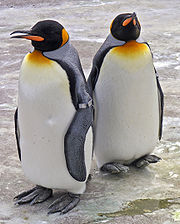
Aptenodytes
Encyclopedia
The genus
Aptenodytes (from the Ancient Greek
a/α 'without' pteno-/πτηνο- 'feather' or 'wing' and dytes/δυτης 'diver') contains two extant species
of penguins collectively known as "the great penguins".
Ridgen's Penguin
(Aptenodytes ridgeni) is an extinct species known from fossil
bones of Early or Late Pliocene
age.
Combined morphological and molecular data have shown the genus Aptenodytes to be basal to all other living penguins, that is, the genus split off from a branch which led to all other species. DNA evidence suggests this split occurred around 40 million years ago.
This had been foreshadowed by an attempt to classify penguins by their behaviour, which also predicted the genus' basal nature.
Genus
In biology, a genus is a low-level taxonomic rank used in the biological classification of living and fossil organisms, which is an example of definition by genus and differentia...
Aptenodytes (from the Ancient Greek
Ancient Greek
Ancient Greek is the stage of the Greek language in the periods spanning the times c. 9th–6th centuries BC, , c. 5th–4th centuries BC , and the c. 3rd century BC – 6th century AD of ancient Greece and the ancient world; being predated in the 2nd millennium BC by Mycenaean Greek...
a/α 'without' pteno-/πτηνο- 'feather' or 'wing' and dytes/δυτης 'diver') contains two extant species
Species
In biology, a species is one of the basic units of biological classification and a taxonomic rank. A species is often defined as a group of organisms capable of interbreeding and producing fertile offspring. While in many cases this definition is adequate, more precise or differing measures are...
of penguins collectively known as "the great penguins".
Taxonomy
- King PenguinKing PenguinThe King Penguin is the second largest species of penguin at about , second only to the Emperor Penguin. There are two subspecies—A. p. patagonicus and A. p...
, Aptenodytes patagonicus - Emperor PenguinEmperor PenguinThe Emperor Penguin is the tallest and heaviest of all living penguin species and is endemic to Antarctica. The male and female are similar in plumage and size, reaching in height and weighing anywhere from . The dorsal side and head are black and sharply delineated from the white belly,...
, Aptenodytes forsteri
Ridgen's Penguin
Ridgen's Penguin
Aptenodytes ridgeni, occasionally called Ridgen's Penguin, is an extinct species of penguin from the Early Pliocene of New Zealand. It was intermediate in size between its living congeners, standing an estimated 90–100 cm tall....
(Aptenodytes ridgeni) is an extinct species known from fossil
Fossil
Fossils are the preserved remains or traces of animals , plants, and other organisms from the remote past...
bones of Early or Late Pliocene
Pliocene
The Pliocene Epoch is the period in the geologic timescale that extends from 5.332 million to 2.588 million years before present. It is the second and youngest epoch of the Neogene Period in the Cenozoic Era. The Pliocene follows the Miocene Epoch and is followed by the Pleistocene Epoch...
age.
Combined morphological and molecular data have shown the genus Aptenodytes to be basal to all other living penguins, that is, the genus split off from a branch which led to all other species. DNA evidence suggests this split occurred around 40 million years ago.
This had been foreshadowed by an attempt to classify penguins by their behaviour, which also predicted the genus' basal nature.
Species
Two monotypic species extant:| Aptenodytes | |||
|---|---|---|---|
| Common and binomial names | Image | Description | Range |
| Emperor Penguin Emperor Penguin The Emperor Penguin is the tallest and heaviest of all living penguin species and is endemic to Antarctica. The male and female are similar in plumage and size, reaching in height and weighing anywhere from . The dorsal side and head are black and sharply delineated from the white belly,... s (Aptenodytes forsteri) |
 |
122 cm (4 ft) tall, weighing 22–37 kg (48.5–82 lb), the adult has deep black dorsal feathers, covering the head, chin, throat, back, dorsal part of the flippers, and tail. The underparts of the wings and belly are white, becoming pale yellow in the upper breast, ear patches are bright yellow. The upper mandible is black, and the lower mandible can be pink, orange or lilac. Males and females are similar in size and colouration. | Circumpolar distribution in the Antarctic between the 66° and 77° S. It almost always breeds on stable pack ice near the coast and up to 18 km (11 mi) offshore. |
| King Penguin King Penguin The King Penguin is the second largest species of penguin at about , second only to the Emperor Penguin. There are two subspecies—A. p. patagonicus and A. p... s (Aptenodytes patagonicus) |
 |
90 cm (3 ft) tall, weighing 11 to 16 kg (24 to 35 lb), The upperparts are steel blue-grey, darkening to black on the head, the belly is white fading to orange on the upper breast with bright orange ear patches. The black bill is long and slender, and curved downwards. The lower mandible bears a striking pink or orange-coloured mandibular plate | Breeds on the subantarctic islands between 45° and 55° S at the northern reaches of Antarctica, as well as Tierra del Fuego Tierra del Fuego Tierra del Fuego is an archipelago off the southernmost tip of the South American mainland, across the Strait of Magellan. The archipelago consists of a main island Isla Grande de Tierra del Fuego divided between Chile and Argentina with an area of , and a group of smaller islands including Cape... , the Falkland Islands Falkland Islands The Falkland Islands are an archipelago in the South Atlantic Ocean, located about from the coast of mainland South America. The archipelago consists of East Falkland, West Falkland and 776 lesser islands. The capital, Stanley, is on East Falkland... , and other temperate islands of the region. |

